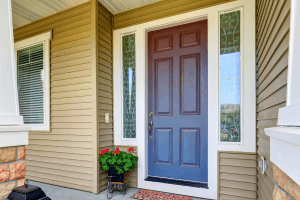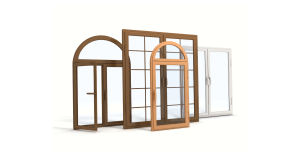People ask a lot from their windows. They expect windows to let in a nice amount of light and fresh oxygen, but also to keep out the cold, damp air, and the heat when they are shut. We also expect them to work for as long as we are living in the house. Regular wood material has been doing this task for decades, but with temperature fluctuation, it can shrink and swell up, and this is referring to ones with exterior cladding. With vinyl windows, the amount of upkeep required is drastically lowered, but the material must be produced into chunky frames that rude the amount of overall glass. Vinyl windows also lose their durability as they get older.
Fibreglass has no such defects. It is more solid and lighter than wood, as low-maintenance as vinyl, and unaffected by variations in water or temperature. Although early models of fibreglass had some drawbacks, technological advances have solved many of the past issues.
Matt Risinger, who is a developer based in Austin, Texas has stated that only fifteen years ago, windows made of fibreglass were only available in certain sizes. He said they turned chalky from exposure to the sun, and only came in a single colour. Nowadays, you get customizable sizes, UV-resistant coatings, a much broader colour selection, and the added option to have a wood interior. The price point for fibreglass windows is also fairly affordable. So if you have a kitchen with certain colours, you can pick out windows to suit the overall colour scheme of the kitchen.
Vitals For Fiberglass Windows
What Is The Cost?
Fibreglass windows are around 25% more costly in comparison to vinyl windows and around half of the price of aluminum-clad wood windows. For a 3-by-5 foot fibreglass window, it will run about $300.
Should You Do It Yourself?
There are some manufacturers that only sell windows if an approved installer does the job. Windows can be available for new home construction or just as a replacement, so hiring a professional is recommended to make sure that the windows will be good to go for the long-term and that they will perform at their peak capacity and ensure no leaks will occur.
How Long Do Fiberglass Windows Last?
Fibreglass windows typically contain a warranty that warranties defects in construction for years to life, or in other words, however long you own your house. With insulating glass, this carries a 20-year warranty against seal failure.
Do They Require A Lot Of Care?
Fibreglass windows don’t require a ton of maintenance other than giving the glass a clean and replacing the weatherstripping every ten years. If the coating on the windows gets scratched, then all it takes is a touch up with 100% acrylic paint.
How Are Fiberglass Windows Made?
The majority of parts in a fibreglass window are fabricated by pultrusion. This is an automated process where lengths of fibreglass roving and strand mat are bathed in a type of resin, covered in a veil of fibreglass, and then put in a heated dye that hardens up the resin. Each part of the window uses separate dyes. The piece that comes out of this process is then cut to length, coated, and then fitted with nylon-reinforced corner blocks that are hidden. When the nylon-reinforced corner blocks are screwed and then glued together, the lines and blocks will form a nice, tidy, and durable joint.
Should You get Fiberglass Windows?
If you’re seeking a window with top-notch performance, decent price, and long-lasting durability, then you should definitely consider getting fibreglass windows.
Pros Of Fiberglass Windows
Fibreglass windows are very resistant to water and moisture. The homeowner won’t have to worry nearly as much about corrosion, rot, mould, shrinking, or swelling in comparison to other types of windows. They are very stable in all types of temperatures and extreme levels of heat or cold won’t cause the fibreglass to sag, flex, or change in dimension. Because of this, the chances of leaks occurring around the window is drastically reduced. With fibreglass windows, there is a lot more glass and a lot less frame. Fibre-reinforced resins are considered to be very strong and as a result, window frames and sashes have the ability to be narrower, a lot less bulky, and at the same time, this narrow frame won’t compromise their resistance to high winds.
Cons Of Fiberglass Windows
Fibreglass windows are considered to be a little more tedious to customize than their wooden counterparts. Fewer colours and hardware options are available as well, so for the person that is trying to find a very unique colour pattern, they might be out of luck. Fibreglass windows are a little tougher to find because only a select few companies manufacture these types of windows, and even fewer distribute them worldwide. The resin in fibreglass can tend to get a little chalky when it is exposed to UV rays. It is very important to get a factory-applied coating on the exterior of the windows, and the thicker you get, the better it is for the window.
Three Styles Of Fiberglass Windows
Fibreglass comes in a few different forms, and each will have its own set of properties.
All Fiberglass
All fibreglass will look like windows with painted wood inside and out. For around 10% more in price, Pella will be able to use different colours on the interior and exterior of the window. Marvin has an optional Everwood finish that looks like stained wood, and this will run you about 15 to 20% more.
Wood Interior
With the wooden interior, the sills, sashes, and frames are still made of fibreglass, but the inside surfaces are shrouded in wood veneer or just pure solid wood. in comparison to 100% fibreglass models, the solid-wood interior style will cost an additional 15%.
Hybrid
The sash of the Andersen A-series window is all fibreglass, and this will move as little as glass. The parts of the interior are all wood and the exterior is made up of a combination of groundwood and vinyl. The price point for this is around the same as a window wood clad in aluminum.
The View Of Fiberglass Windows
Over the years, fibreglass windows have gone through many changes in many different areas.
Coatings
Finishes are a lot tougher and UV resistant than what they used to be. They come with a fairly thick layer of acrylic that is applied during the extrusion process to prevent any scratches or defects. This coating can also be applied as a spray-on paint or powder coating that is added before the assembly of the window.
Colours
Fibreglass windows used to be only available in white, but they now are available in a wide range of colours for both the interior of the window and the exterior. If you decide that you want a different hue of colour later on in the process, then you can paint the fibreglass that is known to be as simple as wood to paint.
Curves
Manufacturers can now mould fibreglass into arch-looking shapes. This is a nice option because the pultrusion process only makes straight pieces.
Combinations
Windows can now be delivered as ready-to-install units. They don’t have to be assembled on-site or come in combined sets like they used to. This makes the whole process much more convenient and time-consuming.
Energy Performance
Fibreglass does a very adequate job of keeping the cold out of the house. If you fill the frame with foam and include triple-pane glazing, this will improve the cold resistance even more. In the long run, this will save you on the energy bill.
What About The Competition?
Vinyl
Fibreglass consistently comes up strong in comparison to materials that are used to make other windows. Vinyl makes for the cheapest and most installed type of window, but it isn’t very durable. With age and long-term exposure to the cold, it gets weaker. Vinyl sashes and frames have very thin walls that are flexible and cannot be repaired. It is also very hard to paint them properly. Because the joints are heat-welded together, it can leave noticeable bumps at the corners.
Clad Wood
Clad wood is considered to be higher-end wood windows and they have an exterior layer of vinyl or metal. This is known to reduce the overall maintenance and will improve longevity as well. Performance-wise, they are very close to fibreglass windows, but with that, they also have a higher price tag.
Aluminum
Aluminum is lightweight and low-maintenance. But it doesn’t have good insulation and is only good for mild climates.
Styles Of Windows
Wide Open
This style includes wood-lined casements that really shows how narrow the window frames are. The sashes on these also can’t warp like the wood ones all too often do.
Seeing Green
Black, green, and dark gray coloured windows are becoming more mainstream nowadays, but they do risk the chance of fading.

Wall of Glass
Larger windows allow larger views, but they also have to defend the high winds. They’re known to withstand winds up to 142 mph.
Bathing Beauty
These windows are resistant to humid air and are great for bathrooms.
Curved Windows
Bowed windows let in a lot of natural light and add much space to a room.
Historic Feel
Used in large gable openings with high center arches, these add a nice rustic look to the homes.

